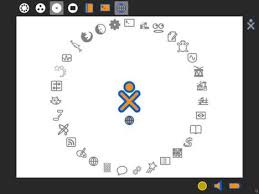Learning on mobile phones
The mobile phone has been promoted by some as more appropriate learning tools for the developing world. They are present in much greater numbers than laptops are likely to ever be and they may be more appropriate technology because they address existing needs as identified by the people.
Conversely, their small screens and limited keyboards limit what can be done.
What would a good learning app for a phone look like? It need not be a visual block programming language but could be.
The pencil and paper amplify thought. We can create a music score, diagram or text of greater complexity on paper than we can hold in our head. The computer, like pencil and paper, allows us to store and inspect our project. Unlike paper, it also can 'play' our project. TamTam, Record, Etoys and Physics are examples that utilise the computer as a player.
The screen is how we transfer a project of great complexity inside the device to the limited representation which is inside our heads. The eye is well adapted to find a smaller piece of information in a larger project and concentrate our attention on it. Does it have to be the screen? A small screen is a problem.
The iPhone has a resolution of 480-by-320-pixels at 163 ppi , I would need glasses but its not that small a screen for young eyes. TurtleArt has a number of features which adapt it to small screens.
I do not think that the phone is too small a platform for serious work. I hope that somebody will create a phone app which follows the educational principles of Etoys: authoring always on, low entry, wide walls, high ceiling and collaborative. It might not be a visual programming tool though.
Conversely, their small screens and limited keyboards limit what can be done.
What would a good learning app for a phone look like? It need not be a visual block programming language but could be.
- Authoring would be always on
- Low entry, wide walls and high ceiling
- Collaborative
- Would give access to the microphone, speaker, camera, screen and networks (Bluetooth, Wifi and phone)
- If an iPhone, it would give access to the Accelerometer, Proximity sensor, Ambient light sensor, Assisted GPS and Digital compass
- It would amplify human thought
The pencil and paper amplify thought. We can create a music score, diagram or text of greater complexity on paper than we can hold in our head. The computer, like pencil and paper, allows us to store and inspect our project. Unlike paper, it also can 'play' our project. TamTam, Record, Etoys and Physics are examples that utilise the computer as a player.
The screen is how we transfer a project of great complexity inside the device to the limited representation which is inside our heads. The eye is well adapted to find a smaller piece of information in a larger project and concentrate our attention on it. Does it have to be the screen? A small screen is a problem.
The iPhone has a resolution of 480-by-320-pixels at 163 ppi , I would need glasses but its not that small a screen for young eyes. TurtleArt has a number of features which adapt it to small screens.
- named stacks of blocks
- collapsible stacks
- zoom in and out
- scrollable canvas
- save and individually restore stacks in trash
I do not think that the phone is too small a platform for serious work. I hope that somebody will create a phone app which follows the educational principles of Etoys: authoring always on, low entry, wide walls, high ceiling and collaborative. It might not be a visual programming tool though.





2 Comments:
I wonder tho, how prevalent smartphones are in developing countries as opposed to more common (cheap) flips or other less "smart" phones.
Once you get away from iPhones, Android phones, and that class of (very expensive) devices, your screen real estate is far, far more limited.
And honestly, I have to question the rationale of a parent who would freely hand a difficult-to-replace $400 iPhone to a small child. What're your contacts and other data on the phone worth? How will you access that vital information when the device has been dropped and the screen rendered unreadable?
Thanks Rob
Yes I guess smartphones are not that common in the third world. As technology gets cheaper, maybe all phones will be smart though.
Tony
Post a Comment
<< Home